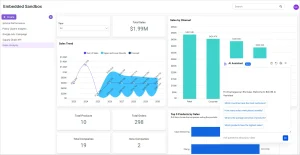Data Privacy Compliance in Sales Operations: Navigating the New Frontier

Let’s be honest. For a long time in sales, data was just… fuel. The more you had, the further you could go. Lead lists were bought and sold, contact details were scraped from websites, and personal information was traded like baseball cards. It was the wild west, and the fastest draw won the deal.
Well, the sheriff is in town. And its name is data privacy compliance.
Today, sales operations isn’t just about optimizing pipelines and automating workflows. It’s about building those processes on a foundation of trust and legal rigor. Getting it wrong isn’t just a missed quota; it’s massive fines, shattered reputations, and a complete erosion of customer trust. Here’s the deal: navigating this new landscape is your single biggest opportunity to build a more resilient, and honestly, a more effective sales engine.
Why Sales Ops is Ground Zero for Data Privacy
Think about the data flowing through your CRM. It’s a treasure trove of personal information: names, email addresses, phone numbers, company roles, sometimes even notes on personal hobbies or pain points. This is precisely the kind of data that regulations like the GDPR in Europe, the CCPA in California, and a growing patchwork of other laws are designed to protect.
Sales operations teams are the stewards of this data. They manage the CRM, oversee the lead flow, and build the automation sequences. That means they’re also on the front lines for compliance. A single misstep—sending a marketing email without proper consent, or failing to delete a contact’s data upon request—can trigger a violation. It’s a huge shift from the “spray and pray” mentality of old.
The Core Pillars of a Compliant Sales Process
So, what does this actually look like in practice? It boils down to weaving privacy into the very DNA of your sales motions.
1. Lawful Basis for Processing: Your “Right to Be Here”
You can’t just process someone’s data because you found it. You need a legally sound reason. For sales, the two most common are consent and legitimate interest.
Consent is the gold standard, but it has to be explicit. A pre-ticked box on a form won’t cut it anymore. Legitimate interest is a bit more nuanced; it means you have a genuine reason to process the data (like selling your product to a business) and it doesn’t override the person’s rights. You need to document this reasoning—it’s your shield if you’re ever challenged.
2. Transparency and Communication: No More Black Boxes
People have a right to know what you’re doing with their information. Your privacy policy needs to be crystal clear, easy to find, and written in plain language, not legalese. Explain what data you collect, why you collect it, and who you share it with. When a sales rep gets a business card at a conference, the follow-up email should ideally reference how they got the data and point to the privacy policy.
3. Data Subject Rights: Honoring the “Off” Switch
This is a big one. Regulations grant individuals powerful rights over their data. Your sales ops systems must be able to handle requests for:
- Access: “Show me all the data you have on me.”
- Erasure (The Right to Be Forgotten): “Delete all my information from your systems.”
- Opt-Out: “Stop emailing me. Now.”
This isn’t a manual task. You need automated workflows in your CRM to find every instance of a person’s data across all integrated tools and fulfill these requests promptly. A 30-day deadline can feel like a blink of an eye when you’re dealing with a complex tech stack.
Practical Steps for Your Sales Ops Playbook
Okay, enough theory. Let’s get tactical. How do you actually build this?
Lead Generation and Scrubbing
First, you have to clean house. Audit your existing database. Where did these contacts come from? Do you have a recorded lawful basis for each one? This can be a monumental task, but it’s essential. For new leads, implement strict processes. Scraping tools? Probably a bad idea. Buying lists? Extremely high risk. Focus on building inbound, permission-based channels.
CRM and Tech Stack Configuration
Your CRM is your command center. Use it to track consent. Create custom fields for “Consent Date,” “Consent Source,” and “Lawful Basis.” Build segmentation lists that separate contacts based on their consent status. This allows your marketing automation to only send emails to those who have explicitly opted-in, avoiding nasty compliance surprises.
And don’t forget your other tools. Your sales engagement platform, your dialer, your analytics—they all need to be part of this compliant ecosystem.
Training and Enablement
Your sales team are the foot soldiers. If they don’t understand the “why,” they’ll see compliance as a barrier to selling. Train them relentlessly. Explain the risks in plain terms. Role-play how to have conversations about data privacy with prospects. Make it a part of your sales culture, not just a set of annoying rules.
| Common Risk Area | Compliant Alternative |
| Adding contacts from LinkedIn to a cadence without context | Using a personalized connection request first, then referencing that interaction in a follow-up if they connect. |
| Storing personal notes (e.g., “has three kids”) in the CRM without a clear business reason | Keeping notes focused on business pain points and project needs. |
| No process for handling “unsubscribe” or “delete my data” requests | Automated workflow in the CRM that routes these requests to a dedicated person/team for immediate action. |
The Silver Lining: Trust as a Competitive Advantage
It’s easy to view all this as a burden. A tax on growth. But that’s a shortsighted view. In a world where consumers are increasingly wary of how their data is used, demonstrating respect for privacy is a powerful differentiator.
When you are transparent and respectful, you build trust. And trust is the currency of modern sales. A prospect who trusts you is more likely to engage, to take your call, and ultimately, to buy from you. Your compliance framework isn’t a cage; it’s the foundation for a more authentic, and more sustainable, revenue engine.
So the landscape has changed, sure. The wild west has been civilized. But in this new territory, the most valuable asset isn’t the size of your list—it’s the strength of your relationships. And that, when you think about it, is what sales was always supposed to be about.






